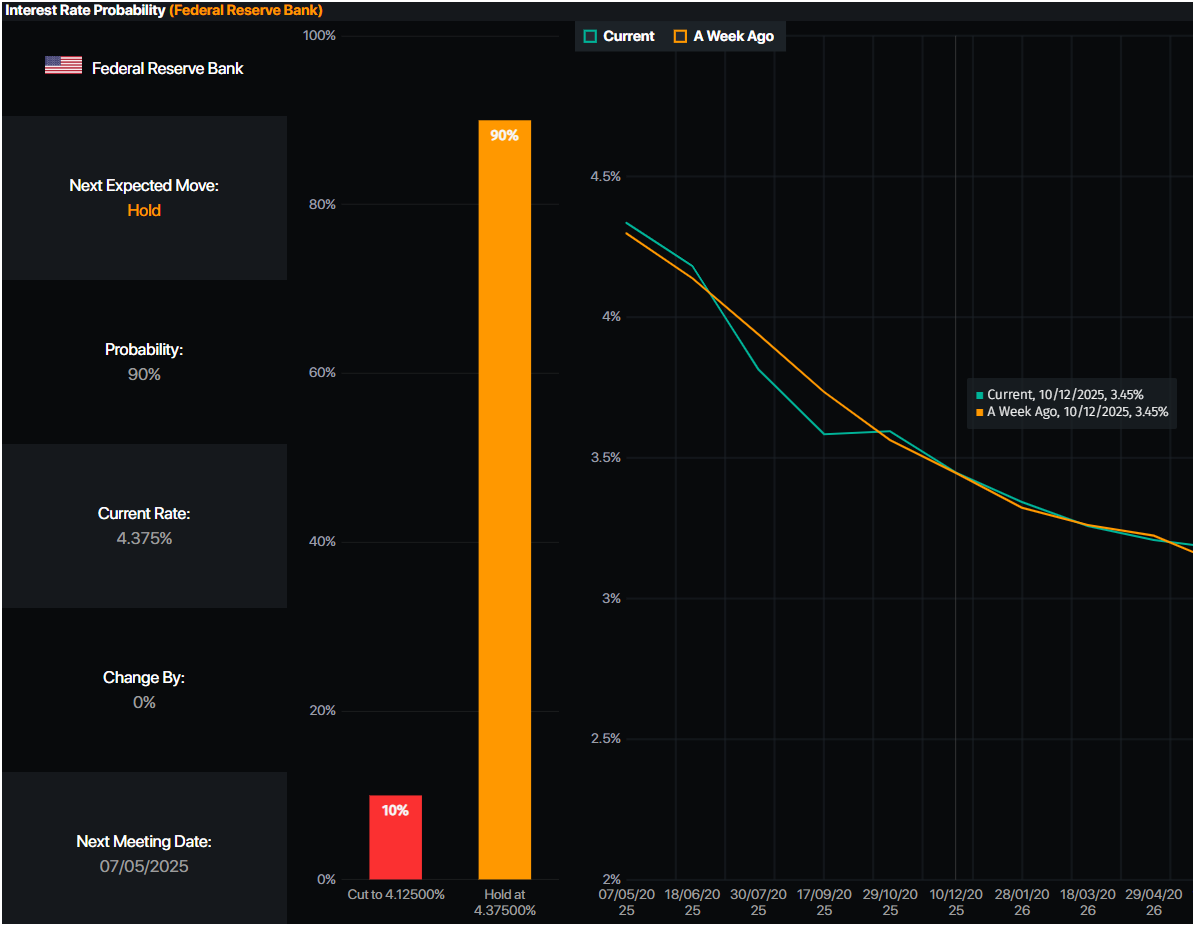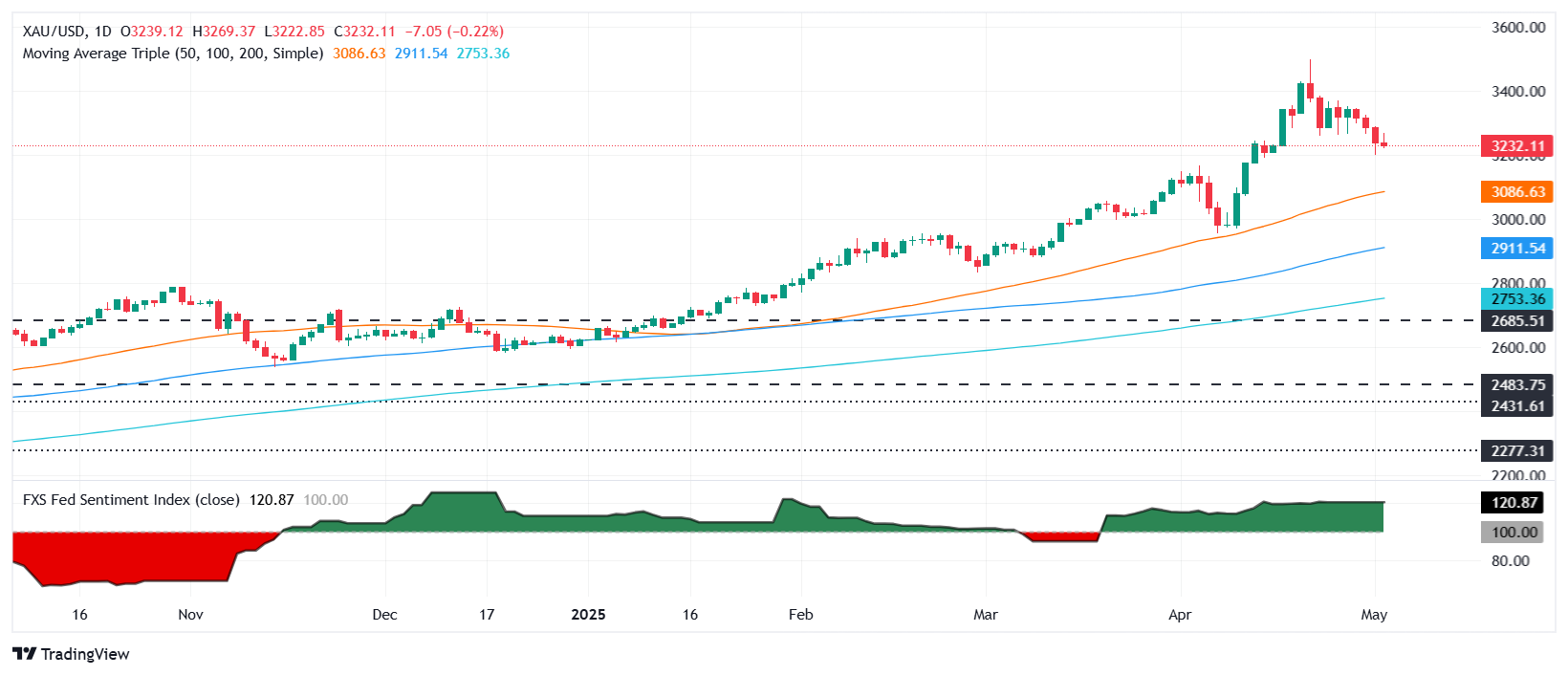Created
: 2025.05.03














![]() 2025.05.03 04:44
2025.05.03 04:44
Gold (XAU/USD) price edged down over 0.35% on Friday, poised to end the week with losses of over 2.50%. An improvement in risk appetite due to easing trade tensions alongside a strong labor market report in the United States (US) prompted investors to book profits ahead of the weekend. At the time of writing, XAU/USD trades at $3,226 after retreating from a daily high of $3,269.
Overnight news revealed that China's commerce ministry said the US was willing to begin trade talks and tariffs and reassured Washington that Beijing's door is open for discussions.
Bullion prices extended their losses on the headline that Nonfarm Payrolls in April crushed estimates, with the Unemployment Rate holding firm compared to March numbers. XAU/USD's drop towards the day's low of $3,222 was precipitated by traders reducing their bets that the Federal Reserve (Fed) would cut rates three times instead of four.
US Treasury yields rose sharply, but the US Dollar Index (DXY), which tracks the Greenback's performance against a basket of six other currencies, tumbled 0.20% to 99.98.
After the data release, investors rushed to price in 78 basis points of Fed rate cuts, as revealed by data from Prime Market Terminal.

Source: Prime Market Terminal
Next week, Gold traders are eyeing the release of the Federal Reserve's monetary policy meeting, during which the US central bank is expected to keep rates on hold.
XAU/USD technical outlook: Gold price remains bullish but poised to drop below $3,200
The Gold price correction extended below $3,250 after traders tried to reclaim $3,270 but failed. The Relative Strength Index (RSI) shows that sellers are gathering steam; hence, a drop below the $3,200 figure is likely.
In that outcome, the next support would be the April 3 high, which turned support at $3,167. Once surpassed, the next stop would be the 50-day Simple Moving Average (SMA), at $3,080. Conversely, if buyers lift Gold prices above $3,300, it would clear the path to challenge $3,350, followed by $3,400.

Gold has played a key role in human's history as it has been widely used as a store of value and medium of exchange. Currently, apart from its shine and usage for jewelry, the precious metal is widely seen as a safe-haven asset, meaning that it is considered a good investment during turbulent times. Gold is also widely seen as a hedge against inflation and against depreciating currencies as it doesn't rely on any specific issuer or government.
Central banks are the biggest Gold holders. In their aim to support their currencies in turbulent times, central banks tend to diversify their reserves and buy Gold to improve the perceived strength of the economy and the currency. High Gold reserves can be a source of trust for a country's solvency. Central banks added 1,136 tonnes of Gold worth around $70 billion to their reserves in 2022, according to data from the World Gold Council. This is the highest yearly purchase since records began. Central banks from emerging economies such as China, India and Turkey are quickly increasing their Gold reserves.
Gold has an inverse correlation with the US Dollar and US Treasuries, which are both major reserve and safe-haven assets. When the Dollar depreciates, Gold tends to rise, enabling investors and central banks to diversify their assets in turbulent times. Gold is also inversely correlated with risk assets. A rally in the stock market tends to weaken Gold price, while sell-offs in riskier markets tend to favor the precious metal.
The price can move due to a wide range of factors. Geopolitical instability or fears of a deep recession can quickly make Gold price escalate due to its safe-haven status. As a yield-less asset, Gold tends to rise with lower interest rates, while higher cost of money usually weighs down on the yellow metal. Still, most moves depend on how the US Dollar (USD) behaves as the asset is priced in dollars (XAU/USD). A strong Dollar tends to keep the price of Gold controlled, whereas a weaker Dollar is likely to push Gold prices up.
![]()
Created
: 2025.05.03
![]()
Last updated
: 2025.05.03

FXStreet is a forex information website, delivering market analysis and news articles 24/7.
It features a number of articles contributed by well-known analysts, in addition to the ones by its editorial team.
Founded in 2000 by Francesc Riverola, a Spanish economist, it has grown to become a world-renowned information website.
We hope you find this article useful. Any comments or suggestions will be greatly appreciated.
We are also looking for writers with extensive experience in forex and crypto to join us.
please contact us at [email protected].
Disclaimer:
All information and content provided on this website is provided for informational purposes only and is not intended to solicit any investment. Although all efforts are made in order to ensure that the information is correct, no guarantee is provided for the accuracy of any content on this website. Any decision made shall be the responsibility of the investor and Myforex does not take any responsibility whatsoever regarding the use of any information provided herein.
The content provided on this website belongs to Myforex and, where stated, the relevant licensors. All rights are reserved by Myforex and the relevant licensors, and no content of this website, whether in full or in part, shall be copied or displayed elsewhere without the explicit written permission of the relevant copyright holder. If you wish to use any part of the content provided on this website, please ensure that you contact Myforex.
Myforex uses cookies to improve the convenience and functionality of this website. This website may include cookies not only by us but also by third parties (advertisers, log analysts, etc.) for the purpose of tracking the activities of users. Cookie policy